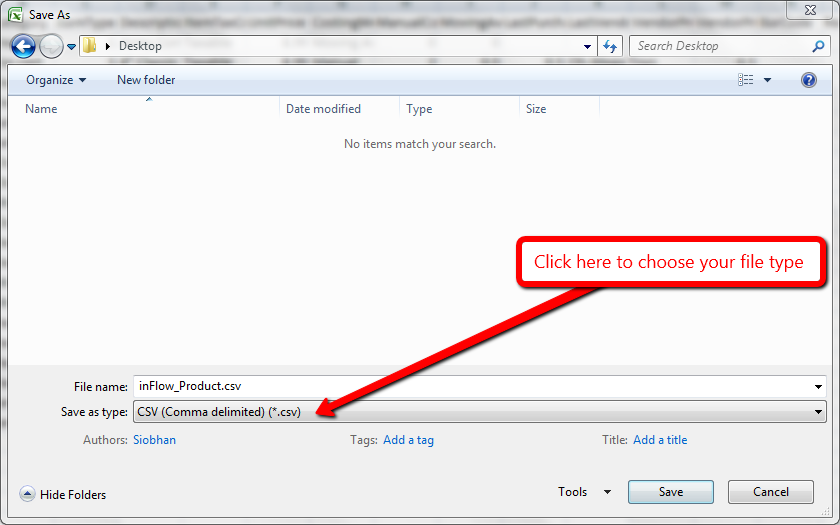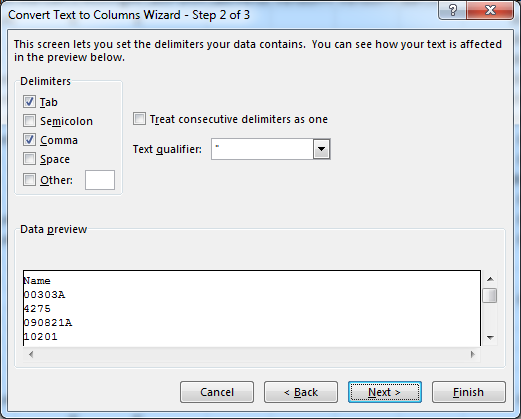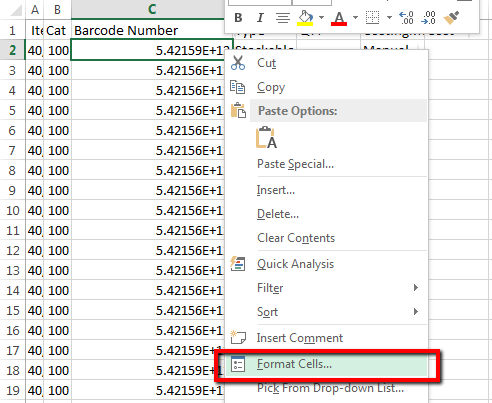If your first attempt to import didn’t work or you’re looking for a little guidance try exporting the type of information that you want to import. To do go go to the Main Menu > General > Export Data and choose the type of data you’re looking to import. This can get you a template to use for inputting your data! You can also have a look here for more information on creating your file.
However if you’ve already created your file for import but you’re still running into problems, we’ve collected some common (and easily fixed) problems that users have noticed with imports below.
1. When importing it looks like you have only one column/everything appears together
The result looks something like this and sometimes happens due to your file being saved in the wrong format. Common reasons for this are Excel’s penchant for re-saving files as Unicode Text instead of CSV (comma delimited), and European (or French Canadian) operating systems where the delimiter is a semi-colon “;” and not comma “,”.
First try re-saving your file from Excel by using the “Save as…” option when saving and choosing “CSV (comma delimited)” as your file type at the bottom of the screen as in the example below:

The problem is easily solved by correcting your Excel file.
1. In Excel, click the “Data” tab at the top.
2. Highlight the first column (“Column A”) and click on “Text to Column”.
3. It will ask you to choose the file type as “Delimited” or “Fixed Width”. Choose “Delimited”.

4. On this next screen, check “TAB” and “COMMA” for delimiter types. Hit “Next”, then hit “Finish”.
5. Re-save your file as a .csv file, just in case… by going to “Save as”.
2. I’m getting an error which says, “required fields missing”
For every import there are several fields that are required while others are optional. If you’re getting an error saying that required fields are missing, first check your required fields to be certain they’re included in your file. There are different required fields for each type of data so please see the table below:
| Data Type | Required Fields |
| Customer | Name |
| Vendor | Name |
| Product | Item Name/Code |
| Inventory | Item Name/Code, Location, Quantity |
| Sales Order | Customer Name, Order Date, Item Name/Code, Quantity |
| Purchase Order | Vendor Name, Order Date, Item Name/Code, Quantity |
| Bill of Materials | Finished Item, Componen tItem, Quantity |
If you’re sure that all your required fields are full you may try adding an additional column to your file in which you’ll place 1’s for each row that contains information. Since we’re using CSV, empty cells at the end of a row can sometimes confuse the system so adding this column can correct that issue (you won’t be importing it so it will not appear in your database).
3. My barcode values have changed/rounded up after I saved!

If you have long barcode values and they now show 4.12E+11 instead of 41234053958 , this is because Excel likes to round your numbers to make them look nicer. To fix the issue, highlight the barcode column, right-click select “Format Cells” and go to “Number”. Here, change the decimal from 2 places to 0 places. You should see the number change back to the correct format. Save it, and then do your import.
If you re-open your .csv file again after this you’ll see that Excel’s changed it back to the “neat” version despite what you have saved before. This means unfortunately you’ll need to re-format it each time you open your .csv file.

